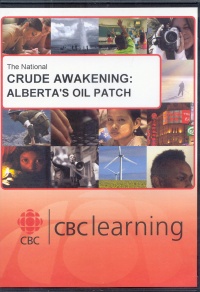| ________________
CM . . . . Volume XVIII Number 30 . . . . April 6, 2012
excerpt:
Have you wondered why President Obama's administration in January 2012 rejected TransCanada's application to build and operate the Keystone XL pipeline, or why the European Union in February 2012 considered placing an international warning label on oilsands crude that would classify it as 22% "dirtier" than regular crude oil? Crude Awakening: Alberta's Oil Patch is a documentary that helps viewers to begin to make sense of both events. In this film, first shown on CBC's The National, reporter Darrow MacIntyre states that, while Alberta's tar sands transformed Canada into a world energy super power, the "dirty expensive process" of extracting every drop of oil from the thick, tarry sand and clay comes at a "staggering environmental cost" that is "turning Canada into one of the biggest polluting countries in the developed world." McIntyre supports these claims with statistics and excerpts of interviews with Dr. David Schlinder, a limnologist and Killam Memorial Professor of ecology, Dr. Kevin Timoney, an ecologist and statistician, Simon Dyer, policy director at the Pembina Institute, and Raymond Ladouceur, a Métis trapper and fisherman. One of Schlinder's worries is the enormous tailings ponds, covering 80 square kilometres, that he describes as "a real toxic soup of things." The water in these ponds includes not only particles of sand and clay and oil, but also contaminants, such as mercury and arsenic, and carcinogenic polycyclic aromatic hydrocarbons (PAHs) associated with oil production. It is unlikely, given the tests that have been done on the levels of toxicity over time, that the ponds can be reclaimed: "They're huge, and there is no known way of doing it." The toxins, in the meantime, are seeping into the ground water and into the Athabasca River that flows into Lake Athabasca and First Nations communities, including Fort Chipewyan. Ladouceur, who lives off the land and water surrounding Fort Chipewyan, describes the negative consequences on the environment and the fish pulled from the water of Lake Athabasca. Timoney talks about the health risks to the people of Fort Chipewyan where rare forms of bile duct cancers are 30% higher than in southern Alberta. He has data to show that the levels of contaminants in the water and fish are over the acceptable regulated guidelines from the Canadian Council of Ministers of Environment, and that the health risk to the people is greater than the provincial government has alleged. A cover up is suggested as a "very plausible explanation." As the environmental costs pile up, Schlinder and Dyer want the pace of the extraction of oil from the Athabasca tar sands slowed down. Schlinder would like to see a reduction of water consumption by one half, green house gas emissions down to one half the current levels, and the land reclaimed. Dyer argues that the entire process could be carbon neutral and that the cost to the oil companies would be only a couple of dollars added on to the $36 production cost of a barrel of oil, which was selling for $90. Unfortunately, neither sees this kind of leadership coming from the Alberta or Canadian governments. MacIntyre, however, ends the documentary with a ray of hope. He suggests that more and more Albertans want a "better balance between industrial development and protecting the things that really make this province great before it is too late." Protecting the environment, of which we are part, is a priority all Canadians should be behind. Crude Awakening: Alberta's Oil Patch, albeit a 23 minute synthesis of information, is enough to get one thinking about the benefits (for whom?) and costs (for whom?) and what we need to live sustainably on the planet. Highly Recommended. Barbara McMillan is a teacher educator and a professor of science education in the Faculty of Education, the University of Manitoba.
To comment
on this title or this review, send mail to cm@umanitoba.ca.
Copyright © the Manitoba Library Association. Reproduction for personal
use is permitted only if this copyright notice is maintained. Any
other reproduction is prohibited without permission.
NEXT REVIEW |
TABLE OF CONTENTS FOR THIS ISSUE
- April 6, 2012.
AUTHORS |
TITLES |
MEDIA REVIEWS |
PROFILES |
BACK ISSUES |
SEARCH |
CMARCHIVE |
HOME |
